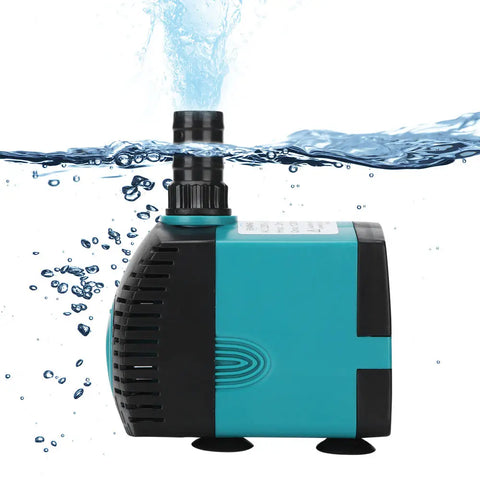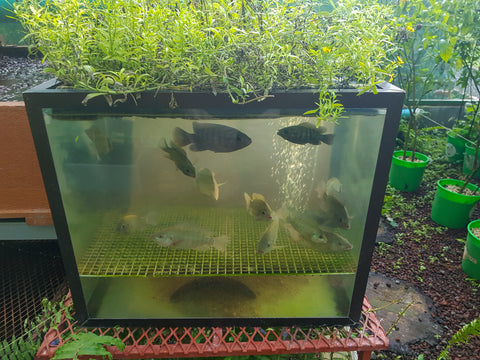In aquaponics, fish waste provides nutrients for plants, while the plants help filter and clean the water for the fish. The key component that facilitates this symbiotic relationship is the water pump, which plays a crucial role in circulating water, nutrients, and oxygen throughout the system.
The placement of the pump within an aquaponics system is essential for optimizing its efficiency and overall performance. Proper pump placement ensures that water and nutrients are distributed evenly to all components of the system, which promotes healthy plant growth and maintains a balanced ecosystem for the fish. Strategically positioning the pump can also help maximize water circulation, nutrient uptake by plants, and oxygenation levels in the system, which leads to higher yields and healthier produce.
This article discusses the correct pump placement within your aquaponics setup. We recognize that the positioning of the pump plays a pivotal role in the overall functionality and effectiveness of the system.
The Importance of Water Pump in Maintaining System Functionality
At the heart of every aquaponics system lies the water pump, a component that is responsible for circulating water and nutrients throughout the system. The water pump ensures that fish waste is efficiently transported to the grow beds where plants can utilize the nutrients, and it also aids in oxygenating the water, which is crucial for the health of both fish and plants. Without a properly functioning pump, the delicate balance of the aquaponics ecosystem can be disrupted, which can lead to stagnant water, nutrient deficiencies, and poor growth and health of both fish and plants.

The Role of Water Pump in Circulating Water and Nutrients
The pump serves as the circulatory system of the aquaponics setup. Its primary functions include:
- Transporting water: The pump moves water from the fish tank to the grow beds, ensuring a constant flow of nutrient-rich water to the plants.
- Distributing nutrients: As water passes through the grow beds, fish waste and other organic matter are broken down by beneficial bacteria, releasing nutrients that are then absorbed by the plant roots.
- Oxygenation: The pump also helps aerate the water by creating turbulence and surface agitation, facilitating the exchange of oxygen and carbon dioxide, vital for the health of both fish and plants.
The Importance of Pump Placement and Overall System Performance
The placement of the pump within the aquaponics system directly impacts its performance and efficiency.
- Pump location affects water flow: Placing the pump at strategic points in the system can optimize water circulation and ensure all areas receive adequate nutrient delivery.
- Efficiency and energy consumption: The distance and height the pump needs to lift water can influence energy usage. Optimal placement can minimize energy consumption while maximizing system productivity.
- Accessibility and maintenance: Pump placement should consider ease of access for routine maintenance tasks, such as cleaning and repairs.
- Temperature regulation: The location of the pump can influence water temperature, which is critical for maintaining optimal conditions for fish and plant growth.
Factors to Consider When Placing the Pump
1. Location of Grow Beds and Fish Tank
When determining the placement of the pump in your aquaponics system, it is crucial to consider the physical layout of your grow beds and fish tank. The pump should be strategically positioned to ensure efficient water circulation between these components. Placing the pump closer to the fish tank can help facilitate the movement of nutrient-rich water to the grow beds, where plants can absorb essential nutrients. Additionally, the pump's location should promote even distribution of water throughout the system to prevent stagnation and nutrient depletion in certain areas.
2. Consideration of Water Flow and Pressure Requirements
Another important factor to take into account when placing the pump is the water flow and pressure requirements of your aquaponics system. Different types of plants and fish species may have varying water circulation needs, so the pump should be positioned to meet these specific requirements. Adequate water flow is essential for delivering nutrients to plants and maintaining oxygen levels for fish. By understanding the flow and pressure demands of your system, you can optimize pump placement to achieve optimal performance and support the health of both plants and fish.
3. Accessibility for Maintenance and Monitoring
Placing the pump in a location that is easily accessible allows for regular inspection, cleaning, and maintenance tasks to be carried out efficiently. Monitoring the pump's performance and addressing any issues promptly can help prevent system malfunctions and ensure continuous operation. By choosing a convenient location for the pump, you can streamline maintenance procedures and proactively address any potential problems that may arise in your aquaponics system.
Best Practices for Pump Placement in Aquaponics
A. Ideal placement for maximizing water circulation and nutrient distribution:
1. The pump should be positioned at the lowest point in the fish tank or sump to ensure efficient water circulation throughout the system.
2. Placing the pump near the center of the system can help evenly distribute water and nutrients to all grow beds and plants.
3. Consider using a manifold system to divert water flow to different parts of the system, ensuring optimal distribution.
B. Tips for reducing energy consumption and minimizing potential issues:
1. Choose a pump size that matches the system's water volume and flow requirements to avoid overworking the pump and wasting energy.
2. Regularly clean and maintain the pump to prevent clogging and reduce strain on the motor, leading to increased energy efficiency.
3. Install a timer or controller to regulate pump operation based on the system's needs, reducing unnecessary energy consumption during off-peak times.
C. Examples of successful pump placement strategies
1. In a media bed aquaponics system, placing the pump at the bottom of the fish tank and using a bell siphon can create a continuous flow of water through the grow beds, promoting nutrient distribution.
2. For a nutrient film technique (NFT) system, positioning the pump at the end of the channel and using a drip irrigation system can ensure a steady flow of water and nutrients to the plant roots.
3. Utilizing a recirculating aquaculture system (RAS) design, placing the pump in the sump tank and incorporating a biofilter can maintain water quality while efficiently circulating nutrients throughout the system.

Ideal Pump Placement Options
1.Directly in the fish tank:
Pros:
- Direct access to fish waste for nutrient-rich water.
- Simplified plumbing setup with fewer connections.
- Minimal risk of clogging due to debris in the fish tank.
Cons:
- Increased risk of fish interference with the pump.
- Limited options for pump size and type due to submersion requirements.
- Potential for pump noise and vibration affecting fish behavior.
Impact on fish health and system efficiency:
Positive impact:
- Directly accessing fish waste ensures efficient nutrient delivery to plants.
- Continuous water movement helps prevent waste buildup and maintains water quality.
Negative impact:
- The presence of the pump in the fish tank may cause stress or injury to the fish.
- Pump noise and vibration could disturb fish, affecting their behavior and health.
2.Below the fish tank:
Pros:
- Reduced risk of fish interference with the pump.
- Enhanced flexibility in pump selection and installation.
- Lower risk of pump noise and vibration affecting fish.
Cons:
- Potential for clogging due to debris settling at the bottom of the tank.
- Increased complexity in plumbing setup with additional piping required.
- Higher risk of pump damage from sediment accumulation.
Considerations for water circulation and nutrient distribution:
- Adequate pump capacity and positioning are essential to ensure efficient water circulation and nutrient distribution.
- Regular maintenance, such as cleaning intake filters and monitoring sediment buildup, is necessary to prevent clogging and maintain system performance.
Troubleshooting Common Pump Placement Issues
A. Uneven Water Distribution:
Uneven water distribution in an aquaponics system can lead to inconsistent nutrient delivery to plants, affecting their growth. This issue often arises when the pump is not positioned correctly or when there are obstacles obstructing water flow.
Solutions:
1. Adjust the pump placement: Ensure that the pump is positioned centrally to allow for equal water distribution to all grow beds and the fish tank.
2. Use additional piping or fittings: Install additional piping or fittings to redirect water flow and ensure even distribution throughout the system.
3. Regularly monitor and adjust: Regularly check the water flow in different parts of the system and make adjustments as needed to maintain uniform distribution.
B. Clogging:
Clogging of the pump or pipes can occur due to debris, algae, or excess fish waste in the system, leading to reduced water flow and potential pump damage.
Solutions:
1. Install a pre-filter: Place a pre-filter on the intake of the pump to prevent large debris from entering and clogging the system.
2. Regular maintenance: Clean the pump and pipes regularly to remove any buildup of debris or algae that could cause clogging.
3. Use appropriate filtration: Implement a filtration system in the aquaponics setup to remove solid waste and maintain water quality, reducing the risk of clogging.
C. Noise:
Excessive noise from the pump can be disruptive and indicate potential issues with the system, such as air bubbles or mechanical problems.
Solutions:
1. Check for air leaks: Inspect the pump and piping for air leaks that could be causing noise and affecting pump performance.
2. Adjust water levels: Ensure that the water levels in the system are at the appropriate height to prevent splashing and noise.
3. Lubricate moving parts: Regularly lubricate the pump's moving parts to reduce friction and noise, improving overall performance.
Conclusion
The placement of the pump in your aquaponics system plays a crucial role in ensuring the efficient circulation of water and nutrients essential for the health of your plants and fish. Carefully considering factors such as water flow, pressure requirements, and accessibility, can help you optimize the performance of your system and promote sustainable growth. Regular monitoring and adjustment of pump placement will help you maintain a thriving aquaponics setup.






Alain Duroisel
March 16, 2024
très bonnes explications !!! bravo et Merci !